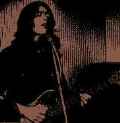|
Mailing & Discussion List  |
|
|
|
|
|
|
| Forward to next article |
| KILLOWATT The
page that gets into gear |
 "But I must admit
I relate more to the Blues than all this Space Invaders rock, leather
jeans and smoke bombs! I think ultimately they restrict the music. I'd
like to think that we can play on the same bill as some of those bands
and give them a real run for their money without resorting to the Cecil
B De Mille bits. Flying Vs and banks of stacks aren't really me.
"But I must admit
I relate more to the Blues than all this Space Invaders rock, leather
jeans and smoke bombs! I think ultimately they restrict the music. I'd
like to think that we can play on the same bill as some of those bands
and give them a real run for their money without resorting to the Cecil
B De Mille bits. Flying Vs and banks of stacks aren't really me. |
Mailing & Discussion List  |
|
|
|
|
|
|
| Forward to next article |